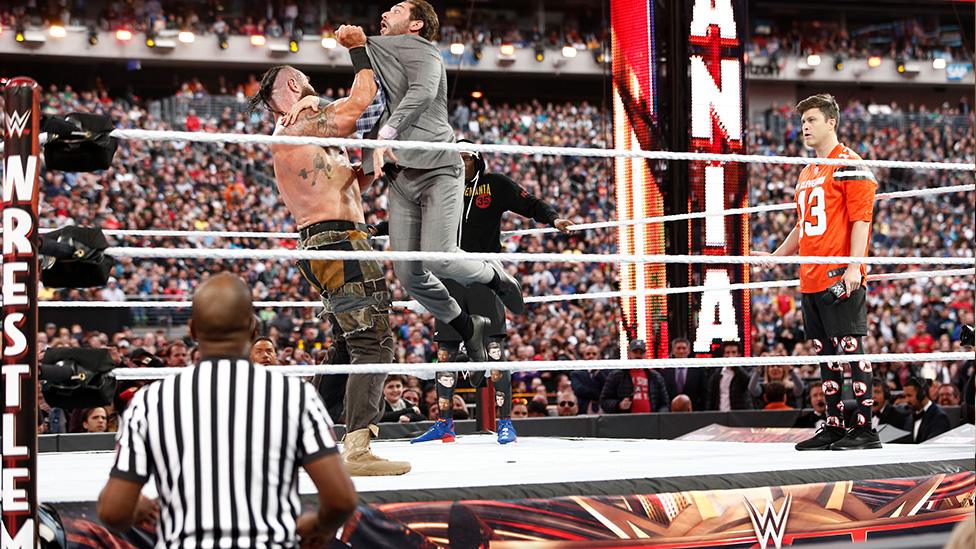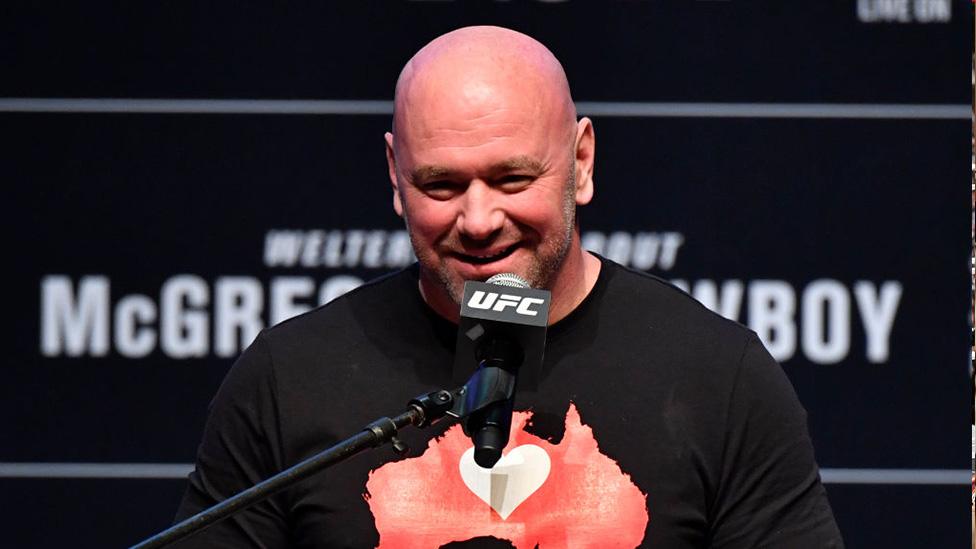Coronavirus: With Wrestlemania, the show must go on no matter what
- Published

At Wrestlemania 35, thousands cheered. But this year it was filmed with no audience
Football, basketball, baseball - all cancelled because of coronavirus. But when it comes to wrestling, must the show go on?
Wrestlemania is the Super Bowl of wrestling, attracting thousands of fans a year and watched on television by many more.
This year, the event held without an audience for the first time and broadcast over the weekend of 4-5 April from the World Wrestling Entertainment's (WWE) training facility in Florida.
Fifty-three performers appeared across 18 matches, including one match with five wrestlers and one referee in the ring at once.
And another segment saw around 10 people - including recently-signed former NFL star Rob Gronkowski - in a brawl.
The broadcast took place days after Florida governor Ron DeSantis issuing a state-wide stay-at-home order as the number of confirmed coronavirus cases in Florida reached over 14,000, with 283 deaths.
As coronavirus has spread through the US, sports events around the country have been cancelled or postponed.
WWE faced calls to cancel Wrestlemania. Critics pointed to Roman Reigns, one of its most prominent wrestlers, who said he "made a choice" to pull out of the main event.
Reigns has had leukaemia - a type of cancer - and returned to wrestling when it went into remission in 2019.
But the programme went ahead.
Many of the performers took to social media ahead of the event to argue that the show must go on not despite Covid-19, but because of it.
Allow X content?
This article contains content provided by X. We ask for your permission before anything is loaded, as they may be using cookies and other technologies. You may want to read X’s cookie policy, external and privacy policy, external before accepting. To view this content choose ‘accept and continue’.
Wrestlemania isn't the only fighting sport that plans to go ahead.
Mixed martial arts showcase UFC 249 is still slated to go ahead on 14 April.
In late March, UFC president Dana White came under fire for comments he made about coronavirus, external to Yahoo Sports, when he said UFC 249 would be continuing as planned in April.
"The question becomes, how long are we going to do this," he asked. "How long are we going to stay in our houses and hide?

UFC CEO Dana White
"Whether you're a coronavirus expert or not, it's like hiding from cancer," White elaborated.
"I've had a great run. If the coronavirus is what's going to get me, I'm ready. Bring it, corona."
His comments have been echoed by WWE personnel - "people need to be entertained".
WWE officials said they made changes to try and limit the number of people at the event. Only essential personnel were on the closed set, WWE said.
Wrestlemania opened with Stephanie McMahon, chief brand officer of WWE and daughter of owner Vince McMahon, saying that she hoped the show would provide a "diversion during these hard times".
"It is our commitment to… deliver a sense of hope, determination and perseverance," she said.
"And most of all, to entertain you and your family."
As far as everyone involved in the production is concerned, their purpose is to distract from the coronavirus pandemic. But at times, it was hard to marry up that sentiment with the action in the ring.
Wrestlemania could have minimised contact between performers. Matches could have been limited to a maximum of two people in the ring, with static cameras to eliminate the need for manual camera operators.
Instead, the event had multi-person matches, and even a bout between Edge and Randy Orton which featured the wrestlers fighting throughout the backstage area and coming into close physical contact with many people in the production crew.
Fans complained on social media that WWE appeared not to be enforcing a social distancing policy.
It is clear that Wrestlemania was not broadcast live, but it was unclear when the matches were recorded.
The company's decision to go ahead with the show is another in a history of controversial decisions which have drawn criticism from fans for WWE programming to go ahead no matter what.


A SIMPLE GUIDE: What are the symptoms?
US v ITALY v CHINA: How do death rates compare?
LEADING THE WAY: The US governor who saw it coming early
ON FRONTLINE: 'Nurses prepare for the worst but not this'
REASON TO HOPE: The good that may come out of this crisis

In 2012, Jerry Lawler suffered a heart attack at ringside whilst commentating on a broadcast of Monday Night Raw. He was transported to hospital and the action in the ring was not halted. Lawler later recovered.
Five years earlier, fans criticised WWE for broadcasting Monday Night Raw hours after it was reported that Chris Benoit, one of the company's leading wrestlers, was found dead at his home with his wife and seven-year-old son. Over the course of the programme, news outlets began reporting that the deaths were a murder-suicide perpetrated by Benoit.
And at a pay-per-view in May 1999, Owen Hart, 33, was being lowered into the ring for a stunt entrance. Something went wrong, and he plunged 50 feet into the ring. He was given CPR in front of the 16,000 fans in attendance, and was ultimately pronounced dead at a hospital.
WWE decided to continue with its Over the Edge pay-per-view event despite the tragic death of one of its wrestlers.
If the deaths of wrestlers were not enough to stop WWE from broadcasting a show, it is perhaps not surprising that the company did not pull its biggest event of the year.